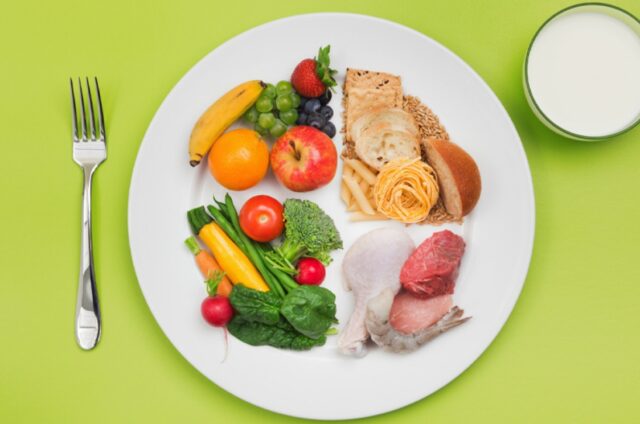
Balanced nutrition is not just a buzzword but a fundamental pillar of a healthy and vibrant life. What we consume plays a crucial role in our overall well-being, affecting our energy levels, physical health, and mental vitality. In this article, we will explore the significance of balanced nutrition, share insights on planning a well-rounded menu, and provide a comprehensive example of a balanced meal that considers calories, vitamins, minerals, and micronutrients. We’ll also discuss essential food items to include in your menu, and offer alternatives for those with allergies or intolerances.

Why We Need To Choose Balanced Nutrition
Balanced nutrition involves providing your body with the essential nutrients it needs to function optimally. A well-balanced diet offers a host of benefits, including:
- Supporting physical and mental health.
- Maintaining a healthy weight.
- Sustaining consistent energy levels.
- Reducing the risk of chronic diseases.
- Enhancing overall well-being and quality of life.
Planning a Balanced Menu:
Creating a well-balanced menu involves selecting foods from various groups to ensure you receive a wide array of nutrients. An ideal menu includes:
- Lean Proteins: Sources such as poultry, fish, lean meats, tofu, legumes, and low-fat dairy are essential for muscle growth and overall health.
- Whole Grains: Choose brown rice, quinoa, whole-grain bread, and oats to provide complex carbohydrates, fiber, and essential nutrients.
- Fruits and Vegetables: A colorful mix of fruits and vegetables offers a broad spectrum of vitamins, minerals, and antioxidants.
- Healthy Fats: Include sources like avocado, nuts, seeds, and olive oil to provide healthy fats that support nutrient absorption and overall health.
- Dairy or Dairy Alternatives: Opt for low-fat or non-dairy alternatives for calcium and protein.

Harmonizing Flavors and Nutrition:
Knowing how to properly assemble a healthy and balanced menu, let’s try to create a well balanced meal example. Using it as a basis, you can change the ingredients and create your ideal menu for every day.
Grilled Chicken Breast with Quinoa and Roasted Vegetables
- 6-ounce grilled chicken breast: Rich in lean protein and essential amino acids.
- 1 cup of cooked quinoa: Provides complex carbohydrates and an array of vitamins and minerals.
- A mix of roasted vegetables (bell peppers, broccoli, carrots): Offers fiber and an abundance of vitamins.
- 2 tablespoons of olive oil for dressing: Provides healthy fats and enhances the meal’s taste.
- A side of mixed greens with a light vinaigrette: Adds freshness and additional nutrients.
Selecting Ingredients and Substitutions:
When selecting ingredients for your balanced menu, keep the following tips in mind:
- Choose whole grains over refined grains whenever possible.
- Select lean cuts of meat and poultry to reduce saturated fat intake.
- Experiment with plant-based protein sources like tofu, tempeh, and legumes.
- Opt for low-fat or non-dairy alternatives for milk and yogurt.

Inclusion and Substitution of Food Items:
- For Allergies or Intolerances:
- Dairy Allergy: Substitute dairy milk with almond, soy, or oat milk.
- Gluten Intolerance: Choose gluten-free grains like rice, quinoa, and gluten-free bread.
- Nut Allergy: Replace nuts with seeds like pumpkin seeds or sunflower seeds.
- Including Essential Foods:
- Legumes: Lentils, chickpeas, and beans are excellent sources of plant-based protein and fiber.
- Fatty Fish: Salmon and mackerel provide omega-3 fatty acids for heart and brain health.
- Leafy Greens: Spinach, kale, and Swiss chard offer vitamins, minerals, and antioxidants.
The Role of Seasonal Produce:
Incorporating seasonal produce into your meals provides several benefits:
- Seasonal fruits and vegetables are fresher, more flavorful, and more affordable.
- They reduce the environmental impact by supporting local and seasonal agriculture.
- Seasonal produce naturally diversifies your diet as different items become available throughout the year.
Planning a Weekly Menu:
To plan a week’s worth of nutritious meals, follow these steps:
- Create a list of your favorite balanced recipes.
- Inventory your pantry and refrigerator to identify ingredients you already have.
- Design your menu based on the ingredients needed.
- Ensure variety and balance, including a mix of protein sources, grains, fruits, and vegetables.

Introducing Fitonist: Your Fitness Companion
Balanced nutrition is complemented by a well-rounded fitness routine. Fitonist App is designed to help you achieve your fitness goals. It offers customizable workouts tailored to your individual needs and progress, allowing you to adapt your exercises as you advance. The app also features an achievement and success tracking function, providing the motivation you need to continue your health and fitness journey.
Conclusion:
Balanced nutrition is the cornerstone of a healthy and fulfilling life. By understanding the significance of a well-balanced diet, selecting ingredients thoughtfully, and planning your meals with care, you can achieve and maintain optimal health and well-being. Whether you’re dining at home or on the go, your commitment to balanced nutrition will empower you to live a healthier and more enriching life.














